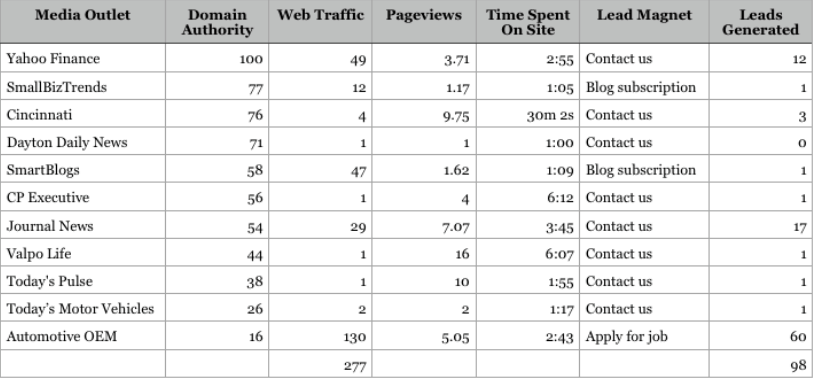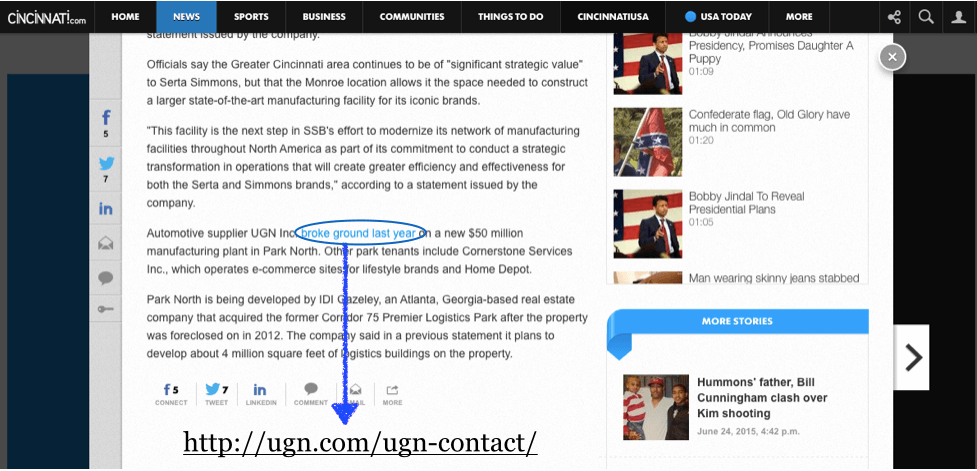Later today (12:00 ET), we are hosting a free webinar on how to use media relations to generate qualified leads.
(You still have time to register, if you’d like to attend live or receive the recording after the event.)
It is the companion piece to how to use media relations for search engine optimization and it is a beast.
There are three areas we discuss that I’d like to outline here, to help you absorb the material and put it into practice:
- Tracking media relations efforts against calls-to-actions;
- Creating lead magnets; and
- Using your own content, lead magnets, and calls-to-action in media relations efforts.
Here is a breakdown of each.
Media Relations and Calls-to-Actions
We have a client that is opening a new facility in Ohio this fall. We’ve been working with the Cincinnati-area media since last spring as the different phases of the plant are complete: Negotiating with the city, groundbreaking, construction, hiring, and (soon) the ribbon cutting.
Not sexy, by any stretch of the imagination, but very effective.
Our goals with each story placed are to get people to subscribe to the blog, apply for a job, or contact the sales team.
So those are what we track against.
You can see, so far this year, we’ve had about a 35 percent return-on-investment, in terms of number of unique website visitors, compared to number of leads generated.
This data also shows us that, while the Cincinnati Enquirer sends very few unique visitors to the site, they are extremely qualified.
They spend at average of 30 minutes on the site and view 10 pages before filling out the contact us form.
There also is a 75 percent conversion, which is extremely high.
This is incredible and almost unheard of. It tells us we need to do more with that newspaper.
Likewise, CP Executive and ValpoLife are big targets—on the latter, people spend more than six minutes on the site and look at 16 pages before filling out the contact us form.
And, of course, Automotive OEM is very effective in passing through job applicants, with nearly half of the visitors contacting HR.
This is stuff I’d much rather have my team report back to the client—versus impressions and advertising equivalency.
The Lead Magnets
So how do we know this?
Let’s take one of the Cincinnati Enquirer stories that has run this year.
You can see, in the story, there is a link with the anchor text, “broke ground last year.” That text links to the “contact us” page on the client’s website.
Now we’re in business so we can track how many people came from that story, how many pages they viewed, and how long they stayed on the site.
Then we can track the additional pages they viewed and whether they revisited the site multiple times or if they contacted the client that same day.
Using the client’s customer relationship software, we then can see whether that person was just kicking the tires or if sales converted them.
In this case, we don’t have access to the client’s CRM so it’s a bit of a game to get the information, but after providing this kind of data against our efforts every year, they’re happy to provide it.
In this case, the lead magnet is “contact us,” but there are a variety of things you can provide behind anchor text:
- A particular piece of content, such as a blog post, white paper, eBook, podcast, or video.
- A downloadable piece of content that sits behind a landing page (so you can collect email addresses), such as a workbook, a template, a checklist, tools, or tips.
- An application to submit for a job.
- A newsletter or blog subscription.
The world is your oyster when it comes to this. Go big or go home, as they say.
Use Your Own Content
If you attended the April webinar (or watched it later) and spend some time with the content on Spin Sucks, you know I’m a big advocate of linking to your own content through your media relations efforts.
Sure, there is some pushback from some journalists who still believe they should only link to articles that are on the media outlet’s site, but that mindset is changing.
So always ask. The worse you’re going to hear is no and then you’ll know either that media outlet doesn’t belong on your list or you’re going to use them solely for brand awareness.
Either is fine, as long as you can explain it—and get buy-in—from your boss or client (it will be an uphill battle until they see the kinds of results I’ve outlined here).
You want to create a plan that includes who your target audience is, what their challenge is, what your solution is, the lead magnet that solves their challenge, how you’ll build a landing page to collect email addresses for marketing, the content you’ll use in your media relations efforts, and what other traffic sources you’ll use to build your audience.
In this case, I used an example from Spin Sucks.
We have a quarterly communications plan template that people love. That is our lead magnet.
The rest of the plan is outlined and you can see that we’ve added that template, as a link, to four different blog posts.
Now the real work begins. We have three steps to take that will take several months to complete:
- Re-share those blog posts, but space them out. Say a week apart.
- Build the visitors to those blog posts through the traffic sources outlined. Say a month apart.
- Begin the media relations efforts to provide contributed content or quotes or interviews to targeted outlets and blogs…and link to one of these blog posts.
In this particular case, our call-to-action is download this template (which gives us their email address and we can now put them into a lead nurturing campaign). But also consider calls-to-action, such as “contact us” or “apply for a job” that I’ve outlined above.
Either way, your media relations efforts now are generating qualified leads that can be tracked against real customers.
And real customers equals money. Money equals your efforts are now an investment and not an expense. And that equals job security.
Hopefully I’ll “see” you on today’s webinar—either live or in the recording later.



